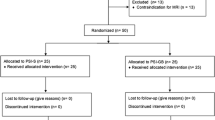Abstract
Purpose
This study aimed to compare the clinical and radiological results of navigation-assisted TKAs performed using the measured gap resection or the gap balancing technique in thirty patients who underwent bilateral primary TKAs.
Methods
Sixty cases of navigation-assisted TKAs [30 TKAs performed using the measured gap resection technique (Group A) and 30 TKAs performed using the gap balancing technique (Group B)] were analyzed prospectively with minimum follow-up of 2 years. The joint line positions were measured using preoperative and postoperative weight-bearing anteroposterior and lateral radiographs. Clinical results were evaluated using knee scores and functional scores.
Results
No significant differences in knee scores or functional scores were observed. Polyethylene thickness and flexion/extension gaps were significantly larger in Group B (P < 0.05). The meaningful proximal shift of the joint line was shown in Group B (P < 0.05).
Conclusion
The navigation-assisted TKA with measured gap resection technique could be a useful technique with regard to restoration of the joint line.
Level of evidence
II.



Similar content being viewed by others
References
Bäthis H, Perlick L, Tingart M, Lüing C, Zurakowski D, Grifka J (2004) Alignment in total knee arthroplasty. A comparison of computer-assisted surgery with the conventional technique. J Bone Joint Surg Br 86:68–682
Bellemans J (2004) Restoring the joint line in revision TKA: does it matter? Knee 11:3–5
Catani F, Biasca N, Ensini A, Leardini A, Bianchi L, Digennaro V, Giannini S (2008) Alignment deviation between bone resection and final implant positioning in computer-navigated total knee arthroplasty. J Bone Joint Surg Am 90:765–771
Chin PL, Yang KY, Yeo S, Lo NN (2005) Randomized control trial comparing radiographic TKA implant placement using computer navigation versus conventional technique. J Arthroplasty 20:618–626
Decking R, Markmann Y, Fuchs J, Puhl W, Scharf HP (2005) Leg axis after computer-navigated TKA: a prospective randomized trial comparing computer-navigated and manual implantation. J Arthroplasty 20:282–288
Donnelly W, Crawford R, Rimmington T, Whitehouse S, Whitting K (2004) Effect of knee navigation on coronal alignment after total knee replacement. J Bone Joint Surg Br 86(Suppl IV):475
Faul F, Erdfelder E, Lang AG, Buchner A (2007) G*Power 3: a flexible statistical power analysis program for the social, behavioral, and biomedical sciences. Behav Res Methods 39:175–191
Figgie HE 3rd, Goldberg VM, Heiple KG, Moller HS 3rd, Gordon NH (1986) The influence of tibial-patellofemoral location on function of the knee in patients with a posterior stabilized condylar knee prosthesis. J Bone Joint Surg Am 68:1035–1040
Haaker R, Stockheim M, Kamp M, Proff G, Breitenfelder J, Ottersbach A (2005) Computer-assisted navigation increases precision of component placement in TKA. Clin Orthop Relat Res 433:152–159
Insall JN, Dorr LD, Scott RD, Scott WN (1989) Rationale of the knee society clinical rating system. Clin Orthop Relat Res 248:13–14
Jung YB, Lee HJ, Jung HJ, Song KS, Lee JS, Yang JJ (2009) Comparison of the radiological results between fluoroscopy-assisted and navigation-guided total knee arthroplasty. Knee Surg Sports Traumatol Arthrosc 17:286–292
Kawamura H, Bourne RB (2001) Factors affecting range of flexion after total knee arthroplasty. J Orthop Sci 6:248–252
Laskin RS (2002) Joint line position restoration during revision total knee replacement. Clin Orthop Relat Res 404:169–171
Malghem J, Maldague B (1989) Depth insufficiency of the proximal trochlear groove on lateral radiographs of the knee: relation to patellar dislocation. Radiology 170:507–510
Mason M, Belisle A, Bonutti P, Kolisek FR, Malkani A, Masini M (2006) An accurate and reproducible method for locating the joint line during a revision total knee arthroplasty. J Arthroplasty 21:1147–1153
Partington PF, Sawhney J, Rorabeck CH, Barrack RL, Moore J (1999) Joint line restoration after revision total knee arthroplasty. Clin Orthop Relat Res 367:165–171
Porteous AJ, Hassaballa MA, Newman JH (2008) Does the joint line matter in revision total knee replacement? J Bone Joint Surg Br 90:879–884
Selvarajah E, Hooper G (2009) Restoration of the joint line in total knee arthroplasty. J Arthroplasty 24:1099–1102
Singerman R, Davy DT, Goldberg VM (1994) Effects of patella alta and patella infera on patellofemoral contact forces. J Biomech 27:1059–1065
Singerman R, Heiple KG, Davy DT, Goldberg VM (1995) Effect of tibial component position on patellar strain following total knee arthroplasty. J Arthroplasty 10:651–656
Sparmann M, Wolke B, Czupalla H, Banzer D, Zink A (2003) Positioning of total knee arthroplasty with and without navigation support. A prospective, randomised study. J Bone Joint Surg Br 85:830–835
Ten Ham AM, Wymenga AB, Jacobs WC (2005) The use of the knee joint-line balancer to control patella position in revision total knee arthroplasty. Knee 12:89–92
Tigani D, Sabbioni G, Ben Ayad R, Filanti M, Rani N, Del Piccolo N (2010) Comparison between two computer-assisted total knee arthroplasty: gap-balancing versus measured resection technique. Knee Surg Sports Traumatol Arthrosc 18:1304–1310
Yoshii I, Whiteside LA, White SE, Milliano MT (1991) Influence of prosthetic joint line position on knee kinematics and patellar position. J Arthroplasty 6:169–177
Acknowledgments
This study was supported by the Chung-Ang University research grants in 2011.
Author information
Authors and Affiliations
Corresponding author
Rights and permissions
About this article
Cite this article
Lee, H.J., Lee, J.S., Jung, H.J. et al. Comparison of joint line position changes after primary bilateral total knee arthroplasty performed using the navigation-assisted measured gap resection or gap balancing techniques. Knee Surg Sports Traumatol Arthrosc 19, 2027–2032 (2011). https://doi.org/10.1007/s00167-011-1468-2
Received:
Accepted:
Published:
Issue Date:
DOI: https://doi.org/10.1007/s00167-011-1468-2




